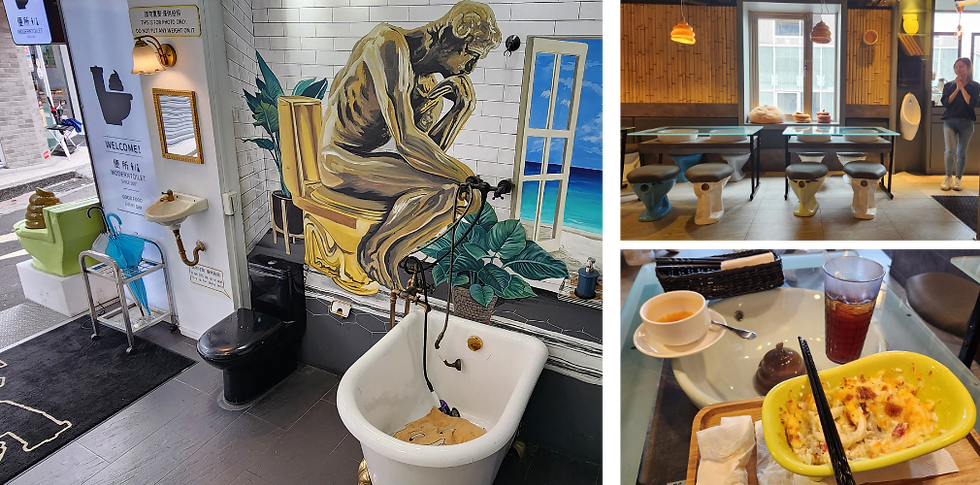Taipei, Part 1: Pineapple Cakes, Crappy Food, Night Market Morsels and a Bunch o' Temples
- Karen Cristello
- Jun 14
- 5 min read
The crappy food isn't what you're thinking...
I came to Taipei for three days of sweltering fun before my main adventure in Vietnam. (Seriously, it was in the 90s °F and relative humidity in the 80s. Boo-hoo!) I'd never been to Taiwan before, so didn't have many expectations. I was delighted to find that it reminded me of Japan in many ways — especially cartoon characters and general cuteness, some of the same food and convenience stores, and cleanliness.

Starting with an upgrade to United's Polaris Business Class set the trip off on the right foot. It makes such a difference to be able to catch some Z's while lying flat (and not head-bobbing or drooling on myself!). Another way to get over jet lag: Force yourself into normal hours by scheduling activities for the beginning and end of the day.

Making Palatably Pleasant Pineapple Cakes
Starting my day with a 9:30 pineapple cake class at CookInn was a perfect jet lag remedy. I'd planned on buying some of these little joys, but then thought it would be much more fun to make them myself. Turns out, they were much more delicious, too — a well-balanced, sweet and slightly acidic pineapple and winter melon paste inside a buttery, soft cookie crust, nice and warm and comforting with a cup of green tea. Yum!!! Fun fact: In Taiwanese, pineapple is called onglai, a word whose characters symbolize prosperity and fortune.

A Truly Crappy but Satisfying Lunch
As for the crappy food... I'd worked up an appetite for lunch, and because I'm still 12 years old at heart, I checked out the hilarious Modern Toilet Restaurant. It's decorated with a toilet theme and the food is named after bodily excretions. I got the seafood rice gratin, something I ate occasionally in Japan, except here it was served in a bathtub. It was pretty good, and enough for two people. They offered poop burritos, poop pancakes, toilet chicken nuggets, dark piss Americano coffee, diarrhea cocoa, and many other charmingly-named treats. I visited the restaurant's location in Shi-men Ting, which is a nice neighborhood to wander around in, with lots of shopping.


A Temple Afternoon: Buddhist, Confucian, and Taoist

First up: Lungshan Temple, one of Taipei's oldest and most renowned religious sites, dating back to 1738. Originally built by Chinese settlers from Fujian, it served as both a place of worship for Guanyin, the Buddhist Goddess of Mercy (I love her!), and a community gathering place. Over the centuries, the temple has been destroyed and rebuilt multiple times due to natural disasters and military conflict, including damage from an American air raid during World War II. It's famous for its stunning, intricate architecture, which combines traditional Chinese palace design with an incredible level of detail in its carvings, paintings, and a unique bronze dragon pillars. (Chinese temples tend to have more imagery and are more ornate than Japanese temples, at least in my observations.) Today, locals come to pray to a mix of Buddhist, Taoist, and folk deities for everything from good health to love.
Then I headed north to the Taipei Confucius Temple. Originally built in 1879, it's a significant cultural landmark. Unlike other highly decorated temples in Taiwan, it is known for its sober and austere design, reflecting the humble nature of Confucianism. This is evident in its simple columns, doors, and windows, which intentionally lack the ornate carvings or inscriptions found elsewhere to show respect for the sage. After the original structure was destroyed during the Japanese occupation (1895–1945), the current temple was rebuilt in 1930 with a layout modeled after the Confucius Temple in Qufu, China. It is particularly famous for its annual ceremony on September 28 (Teachers' Day), which features traditional music and stylized dancing in honor of Confucius.


Across the street was Dalongdong Baoan Temple. Its origins trace back to a wooden shrine built by Chinese immigrants in 1742. The present temple structure, with construction beginning in 1805, is dedicated to Baosheng Dadi, a Taoist god of medicine. (Besides travel, my other passion is medicine, so, yay!) It is a famous example of traditional Taiwanese temple architecture, celebrated for its intricate and masterfully crafted decorative arts, including detailed woodcarvings, murals, and Koji pottery (brightly-colored figures). In 2003, the temple received a well-deserved UNESCO Asia-Pacific Heritage Award for its exemplary restoration efforts. It remains a center for worship, and its annual Baosheng Cultural Festival, featuring parades, traditional performances, and a fire-walking ritual(!), is a major cultural event.

Dinner at the Shilin Night Market: So Much Food, So Little Stomach!

I didn't feel too jet-lagged but my stomach was still full from lunch, so I didn't get to try as many things at the Shilin Night Market as I would have liked. It's a maze of Mandarin, so I was really glad that I hired Ruby, a local guide, to show me around. So worth it! I tried an oyster omelette, a spicy pepper pork bun (so scalding hot it probably took half an hour to cool off enough to eat it), and papaya "milk." Next time I go there, hopefully I'll be with a friend so we can split everything and try more (Ruby wouldn't indulge). They had sausages inside sausages, giant fried chicken cutlets, huge grilled king oyster mushrooms, noodles, and the worst — stinky tofu, which smells so incredibly vile, you couldn't pay me to taste it!

All in all, it was a fantastic, busy first day in Taipei and I looked forward to the next two!




Comments